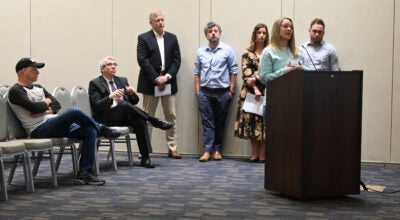Whooping Cough scares
Published 12:00 am Friday, July 27, 2012
By Mark Wineka
mwineka@salisburypost.com
SALISBURY — Teresa Anderson says it was the scariest night of her life.
All of her career training as a clinical pharmacist seemed to go out the window when her then 3-month-old baby, Dylan, vomited, went limp in her arms and stopped breathing.
It followed a prolonged coughing fit — a symptom Anderson was increasingly sure had to be connected to pertussis, more commonly known as whooping cough.
“I started moving him and rubbing him, and then he started crying, so I knew he was OK,” says Anderson, employed by the Hefner VA Medical Center.
She eventually returned Dylan to bed, but an hour later he was coughing and gagging again. For a second time, he stopped breathing — this time for about 5 seconds — and Teresa and Sean Anderson knew they had to take their baby to the hospital.
Today, Dylan Anderson still has shallow remnants of the cough that came close to taking his life, but a round of antibiotics has worked and he’s almost back to full health.
Dylan is one of a worrisome and growing number of cases of pertussis in Rowan County and North Carolina. His is among the four confirmed cases in Rowan for 2012, but that’s already double the two cases for all of 2011.
Statewide, recent outbreaks have renewed calls from health officials, urging North Carolinians to be immunized “against this highly contagious but preventable respiratory disease.”
From last December to the first week of June, the N.C. Department of Health and Human Services has tracked 179 cases of whooping cough touching 23 counties.
In all of 2011, the state had just 126 cases of pertussis confirmed.
Confirmed cases are those in which swabs are taken of the patients and analyzed at the state laboratory, which reports those coming back positive for pertussis.
But Patty Yost, nursing supervisor with the Rowan County Health Department, says Rowan County also has “a high number of probables,” in which children are going to their doctors with symptoms that suggest whooping cough.
The health department, in fact, is bracing for the worst.
“We usually see it at the beginning of school,” Yost says. “I’m really dreading school starting now.”
Vaccine available
A whooping cough outbreak puts a significant burden on local health departments, whose staff must alert everybody who might have come in contact with a confirmed case.
That could involve schools, day cares, Sunday school classes and extensive family and friend contacts. People are informed of their possible exposure to whooping cough, so they can go to their physicians for preventative treatment.
Pertussis is spread from person to person, usually by coughing or sneezing while in close contact.
“The biggest problem is adults are giving whooping cough to children,” Yost says. “We have lost our immunity. The adults are getting it and passing it to small children who haven’t had all their shots yet.”
The state has made the Tdap vaccine (a booster shot) available to local health departments, including Rowan’s. (See the accompanying box for recommendations on whom should consider the shot.)
Yost says she encourages parents of young children, grandparents of infants, teachers, day care and nursery providers — anyone interacting with young children — to get the free vaccine.
Dylan Anderson fit exactly the demographic most in danger when contracting pertussis — infants under a year old, and particularly those under 6 months, who are likely to develop a severe illness if exposed.
At the emergency room, after checking Dylan’s chest X-ray, the Andersons were given some antibiotics for him and the family returned home.
But the next day, their pediatrician admitted Dylan to the hospital for 24-hour observation after Teresa called him in the morning and described the ER visit.
Dylan improved and was allowed to return home again, but the pediatrician told Teresa he had met several of the risk factors that increase an infant’s risk of dying, including an elevated white blood cell count and possible pulmonary hypertension.
A nasal swab, which the Andersons had requested in a previous doctor’s visit, came back positive for pertussis.
By continuing with the antibiotics, Dylan recovered.
His 2-year-old sister, Hayden, and Teresa, who had a booster shot in 2008, both developed coughs and have gone through a round of antibiotics, as has Sean.
Day care classes at Partners in Learning, where Dylan and Hayden attend, have been informed of the other children’s possible exposure.
Warning others
The irony for Teresa Anderson is how much she had been on alert for whooping cough before her baby actually came down with a case. Was she overreacting when Dylan’s nightly coughing fits began?
“Am I just making this up?” Teresa says she asked herself.
The Andersons had just returned from a trip to their families in Minnesota, which is on the Centers for Disease Control and Prevention’s list of states with higher-than-average cases of pertussis.
Minnesota’s was almost 24 percent higher.
Teresa’s sister-in-law told her she was going to get a Tdap booster shot before the Andersons came to Minnesota with Dylan for the first time.
Teresa Anderson also had heard NASCAR driver Jeff Gordon on the radio, promoting a “Sounds of Pertussis” campaign. She even had discussed with the Partners in Learning director about possibly giving teachers administrative time to get free Tdap booster shots.
“It’s kind of bizarre,” Teresa says, “I think all of these things happened so I would recognize my son had pertussis.”
Dylan’s cough started gradually. His mother says he might go six to eight hours without coughing at all. But seemingly out of nowhere, he would let loose with an awful-sounding cough — never with any of the distinctive “whooping” sounds — but sometimes with gagging at the end of a spell.
The Andersons took Dylan to their pediatrician, who was at first skeptical that it could be pertussis because all of the immediate family members had received vaccination boosters.
“Dylan looked like a perfectly healthy little boy, and the coughing was so sporadic that the doctors never witnessed it.” Teresa Anderson adds.
Nightly at home, his coughing spells kept getting worse, lasting longer and with more gagging.
On July 10, Dylan’s day care teachers at Partners in Learning urged Teresa to take him back to their pediatrician because they had witnessed one of his coughing fits and heard the whooping sound for the first time.
On a visit later that day to the doctor is when a nasal swab for pertussis was taken. Before Sean Anderson left with Dylan, the pediatrician also heard the infant’s cough and became concerned that it could be more than a viral illness, though they decided to wait for the swab results, Teresa says.
The severe coughing fit, gagging, vomiting, loss of breath and visit to the emergency room came that night, leading to the prophylactic antibiotic treatment.
In hindsight, Teresa says she wishes she could have made a video of Dylan’s coughing fits so she would have had better testimony, but when your child is going through these ordeals, it’s the last thing on a parent’s mind, she says.
Later, when Dylan was recovering but still had coughing spells, Teresa shot video of an episode and posted it to YouTube. Taken on the second day of his antibiotics, the video is titled, “3-month-old with Whooping Cough (Pertussis).”
Yost says the CDC website also has a video helping parents to recognize the sounds of whooping cough with their infants.
Where Dylan Anderson contracted whooping cough is not known. From loving family members in Minnesota? His day care?
“The scary thing is he probably got it from someone who really cares for him,” Teresa Anderson says. “But he (also) could have gotten it at Walmart — anywhere, really.”
Her own crusade is now clear: She doesn’t want other parents to go through what she and Sean did.
“Anything we can do to get people vaccinated,” Teresa Anderson says.
Contact Mark Wineka at 704-797-4263.
Who should get the Tdap vaccine?
Because of recent outbreaks of pertussis, or whooping cough, the N.C. Department of Health and Human Services has made the Tdap booster shot available for free to anyone 7 years or older.
The booster shot — providing immunization for the prevention of tetanus, diphtheria and pertussis — is available for any child 7 to 10 who did not complete his or her childhood DTaP vaccination series and anyone 11 or older who has not yet received a Tdap booster.
Health officials especially recommend the Tdap booster for the following:
• Women who are pregnant or may become pregnant.
• All close contacts of infants under a year old, such as parents, siblings, grandparents, household contacts and child-care providers.
• Anyone with a pre-existing, chronic respiratory disease.
The DTaP vaccination series is recommended for children starting at 2 months of age and continuing at four months, six months, 15-18 months and 4-6 years of age.
A Tdap booster shot should be given to children by 11 years of age because immunity from the childhood vaccine wears off over time.
Teens and adults who haven’t yet received a pertussis booster shot should also be vaccinated.
The Tdap vaccine booster is offered free of charge through the Rowan County Health Department, but you must make an appointment by calling 704-216-8870 or 704-216-8833.




